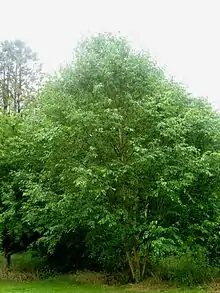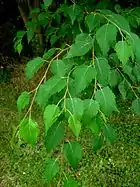| Betula grossa | |
|---|---|
 | |
| Betula grossa, Sir Harold Hillier Gardens, England | |
| Scientific classification | |
| Kingdom: | Plantae |
| Clade: | Tracheophytes |
| Clade: | Angiosperms |
| Clade: | Eudicots |
| Clade: | Rosids |
| Order: | Fagales |
| Family: | Betulaceae |
| Genus: | Betula |
| Subgenus: | Betula subg. Betulenta |
| Species: | B. grossa |
| Binomial name | |
| Betula grossa | |
| Synonyms[2] | |
| |
Betula grossa, commonly known as Japanese cherry birch (Japanese: 梓 azusa), is a species of birch native to Japan, where it grows naturally in mixed woodland on hill and mountain slopes in Honshu, Shikoku , and Kyushu. It was introduced to the West in 1896, but remains rare in cultivation.[3]
Description

Betula grossa is conical in outline, but its most distinctive feature is its cherry-like bark, with horizontal stripes of reddish-grey becoming dark grey with age, exfoliating in thin papery curls. The dark green leaves are up to 10 cm long and turn golden-yellow in autumn. The shoots are aromatic, and carry long, yellow-brown, male catkins in early spring. . The species is considered closely related to the American birch Betula lenta.[3] Hardiness: RHS H4.
References
- ↑ Shaw, K.; Roy , S.; Wilson, B. (2014). "Betula grossa". IUCN Red List of Threatened Species. 2014: e.T194642A2355124. doi:10.2305/IUCN.UK.2014-3.RLTS.T194642A2355124.en. Retrieved 19 November 2021.
- ↑ "Betula grossa". Global Biodiversity Information Facility. Retrieved 31 May 2021.
- 1 2 White, J. & More, D. (2003). Cassell's Trees of Britain & Northern Europe, 304–305 Cassell's, London. ISBN 0304361925
